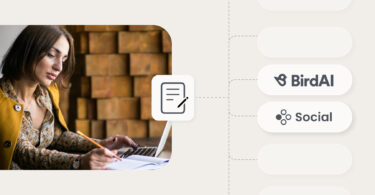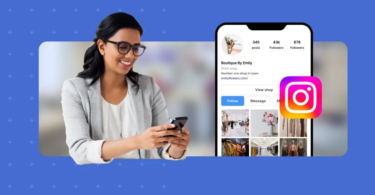Hashtags are more than just a trend; they are a vital tool for businesses aiming to boost their online presence and engage their target audience effectively.
According to a recent survey by Birdeye, 79% of businesses produce their social media content in-house, underscoring the necessity of arming these businesses with the proper tools and strategies for success.
This blog will guide you through selecting, analyzing, and optimizing hashtags to attract your ideal customers. We also share:
- 42 platform-specific business hashtags you must use to grow exponentially
- How to create a memorable hashtag strategy
- Tips to implement to make your hashtags go viral, and many more!
Are you ready to uncover the secrets your competitors wish you didn’t know? Continue scrolling to discover more.
Table of contents
- What are hashtags for business?
- What’s the psychology behind hashtag popularity?
- When to use hashtags that’ll generate your dream customers?
- How does the hashtag algorithm work?
- How to create a memorable hashtag strategy for your brand?
- 40+ platform-specific business hashtags
- How to find the best hashtags for your business?
- What’s the ‘3×3’ hashtag strategy?
- How to connect with your audience through hashtags?
- How to leverage hashtags for event marketing?
- Integrating hashtags with other business marketing strategies
- FAQs on hashtags for business
- Make the best out of hashtags for your business with Birdeye Social
What are hashtags for business?
Hashtags for business are keywords or phrases preceded by the hash symbol (#) used on social media platforms to categorize content, enhance discoverability, and engage with audiences. In business, hashtags are a tool for companies to connect their content with specific topics, trends, or conversations, making it easier for users to find and interact with their posts.
Hashtags can be general, related to broader topics or industries (#fashion, #tech), or specific to a particular brand or campaign (#ShareACoke). When users click on or search for a hashtag, they are shown a feed of posts linked by that hashtag. This feature enables businesses to reach a wider audience beyond their immediate followers.

What’s the psychology behind hashtag popularity?
The psychology behind hashtag popularity, especially for businesses across locations, hinges on several key factors.
1. Sense of belonging
Hashtags tap into the human desire for categorization and order, allowing users to navigate and engage with content relevant to their interests or location.
For multi-location businesses, using location-specific hashtags can evoke a sense of local pride and community, encouraging users to interact with and share content that resonates with their regional identity.
This community-building aspect establishes a localized connection with their audience across different regions.
2. Eagerness to be a part of trending conversations
It feels great to be part of a buzzing group or conversation. When a hashtag starts trending, everyone wants to join the party. The fear of missing out (FOMO) is real for EVERYONE!
That’s the community spirit hashtags can ignite, creating virtual hangout spots for people with shared interests or local ties.
Multi-location businesses can leverage this by participating in or initiating trending location-based hashtags, drawing attention to their presence in various locales.
The simplicity and visibility of hashtags facilitate user participation in social media campaigns, making them powerful tools to engage audiences, enhance brand visibility, and drive user-generated content.
When to use hashtags that’ll generate your dream customers?
While doing regular social media marketing will surely get you customers, to get dream customers, you’ve to tap into the modern trade and explore new opportunities. And one of the best ways is the hashtag marketing.
Here are some ways modern businesses use hashtags in their marketing strategy:
- To start a brand and unique campaign hashtags
- To join trending industry hashtags
- During events and promotions
- For community building and engagement
- To increase their content or product reach
- Organize their content library
Let’s explore them in detail:
1. To start a brand and unique campaign hashtags
Creating a hashtags-specific marketing campaign helps consolidate all posts related to the campaign and makes it easier for users to find and engage with the content.
For example, a company might use #BrandName for general brand-related posts and #BrandCampaign2024 for a specific marketing initiative.
2. To join trending industry hashtags
Join trending conversations with an already engaged audience helps your content get seen by users following that trend. For example, a tech company might use #TechTrends or jump on a trending hashtag like #CES2024 during the Consumer Electronics Show.
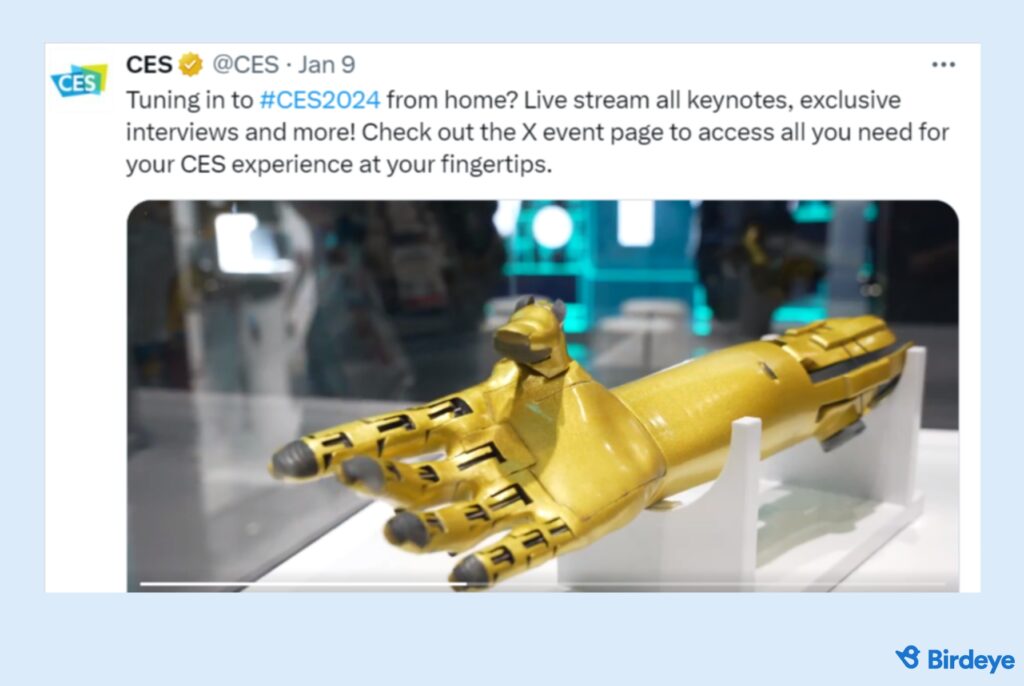
3. During events and promotions
When participating in or discussing events, conferences, or webinars, use the event-specific hashtag. This allows your content to be part of the broader conversation and connects you with attendees and those following the event online.
For conferences, webinars, or product launches, event-specific hashtags help unify the conversation, allowing attendees and those unable to attend to follow along, contribute, and engage with the content and each other.
Here’s an example of when we used an event-specific for Birdeye’s first virtual event, Birdeye View 2023.
4. For community building and engagement
Some businesses use hashtags to foster community or host regular chats on X or LinkedIn.
This encourages customers to share their content with a branded hashtag, which can boost engagement and provide authentic promotional material.
For instance, when promoting our first virtual event, Birdeye View, we used #BirdeyeView and #BirdeyeView2023 with our community.
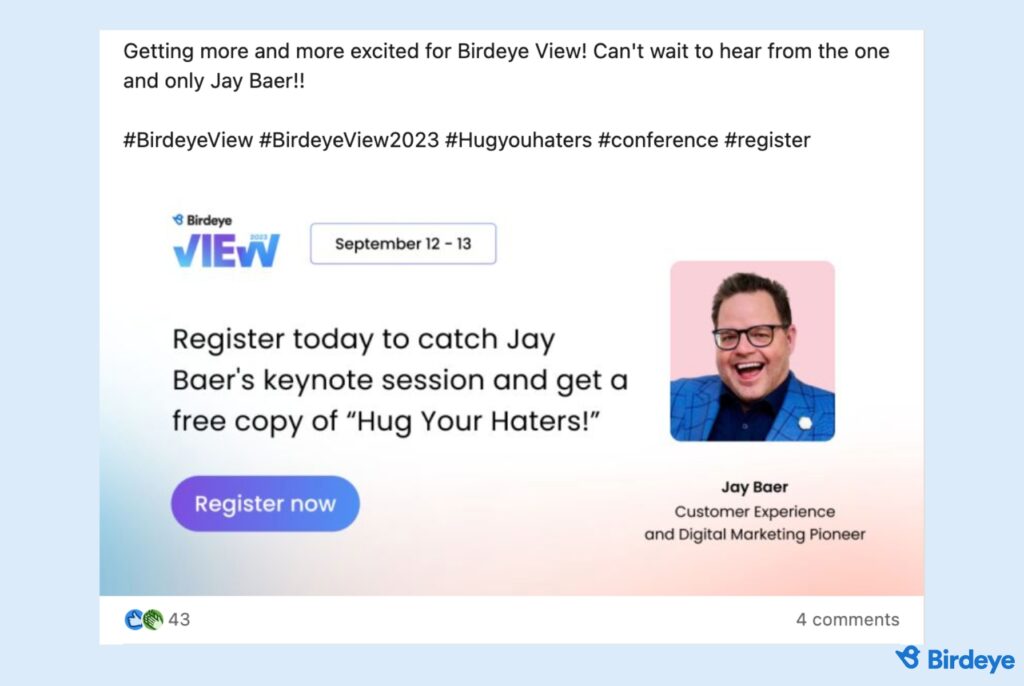
Pro-tip: Use hashtags to align your brand with social causes or movements, showing your brand's values and connecting with users who share those values.
5. To increase their content or product reach
by incorporating relevant hashtags, companies can make it more discoverable to users interested in specific topics. This strategy allows businesses to tap into existing conversations or create new ones, connecting with a broader audience beyond their followers.
These are general hashtags related to the business’s products or content, which are not unique to the brand but are commonly used by consumers.
For example, a bookstore might use #SummerReads to feature seasonal recommendations.
Pro-tip: Birdeye’s AI-powered Social media software helps businesses understand which hashtags generate the most engagement and reach and refine their hashtag strategy.

6. Organize their content library
By assigning relevant hashtags to content, businesses streamline their digital assets into thematic or campaign-specific collections. This organization helps in tracking the performance of different content types or marketing campaigns over time.
Additionally, it simplifies the process of updating or repurposing content, as businesses can quickly search and filter their libraries using designated hashtags.
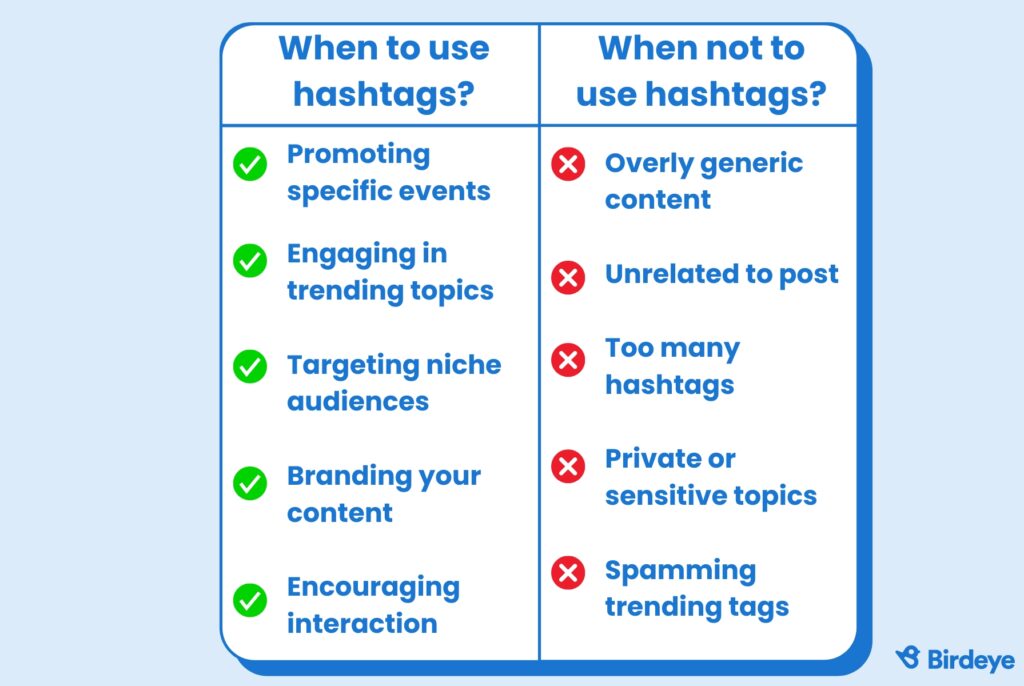
How does the hashtag algorithm work?
The hashtag algorithm, though varying across platforms, significantly impacts content discovery and organization on social media. Hashtags improve how easily users can find and interact with specific topics.
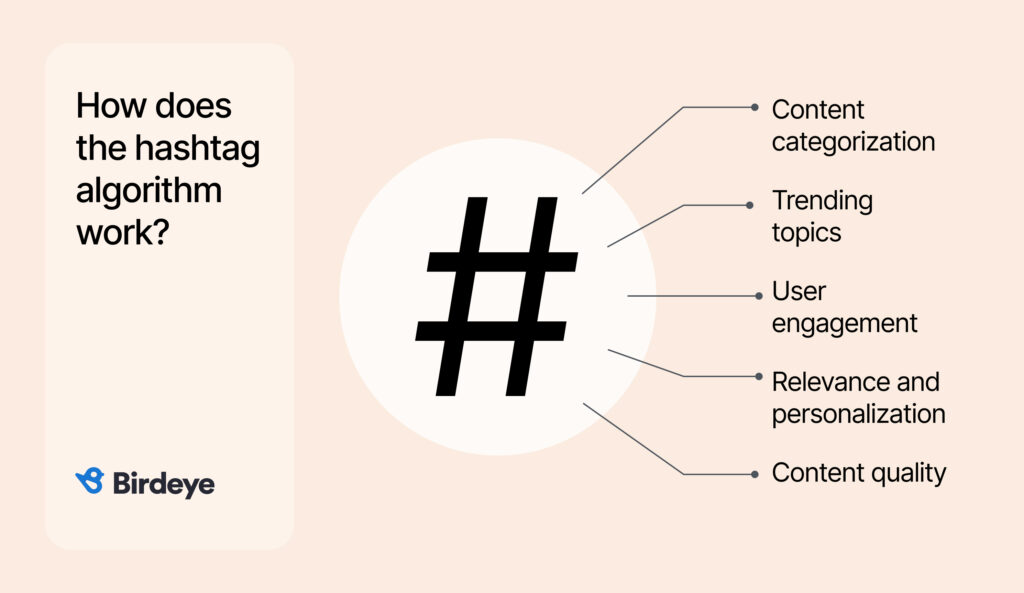
Each platform has its way of leveraging hashtags to categorize and surface content to users. Here’s a general overview of how hashtag algorithms commonly work across various social media platforms:
1. Content categorization
- Purpose: Hashtags allow platforms to categorize content, making it easier for users to find posts related to specific topics or interests.
- Function: When you add a hashtag to your post, the platform indexes it, allowing the post to appear in searches or feeds dedicated to that hashtag.
2. Trending topics
- Identification: Algorithms identify trending hashtags based on a sudden spike in usage over a short period.
- Display: Platforms may highlight trending hashtags to users, encouraging them to view content associated with these tags or participate in the trend.
3. User engagement
- Engagement metrics: The algorithm considers how users interact with hashtagged content, including likes, shares, comments, and the time spent viewing it.
- Prioritization: Content with higher engagement may be prioritized in users’ feeds or search results for a particular hashtag.
Hashtag for Business: Top Strategies & Tips
Want to see the impact of Birdeye on your business? Watch the Free Demo Now.
4. Relevance and personalization
- User preferences: Algorithms analyze individual user behavior, including the hashtags they frequently interact with, to tailor the content in their feed. Newer content is often prioritized to keep feeds and search results fresh and relevant.
- Content suggestion: Users might see suggested posts or be recommended to follow certain hashtags based on their past interactions and preferences. Highly engaging older posts may still appear prominently under certain hashtags.
5. Content quality
- Spam detection: Algorithms are designed to filter out low-quality or spammy content associated with hashtags.
- Quality signals: Factors like account authenticity, user engagement, and the completeness of the profile can influence how content is ranked within hashtag searches.
Did you know Birdeye’s Social media software offers unique advantages for businesses leveraging hashtags effectively? With it, you can: ✅ Track and analyze the performance of hashtags across social platforms. ✅ Gain insights into competitor hashtag strategies and industry trends. ✅ Understand audience engagement and preferences related to hashtag usage. ✅ Optimize hashtag strategies based on comprehensive analytics and data. ✅ Enhance content discoverability and audience reach through targeted hashtags.
How to create a memorable hashtag strategy for your brand?
From the examples stated above, one thing is clear: it’s not just about using hashtags; it’s about using the right ones at the right time to capture the attention of those dream customers and bring them into your orbit.
Drawing from our experience during the Birdeye VIEW 2023 event, here’s a strategy that proved to be highly effective for us:

Let’s discuss these in detail.
1. Brainstorm keywords
List keywords related to your business, brand, and the products or services you offer. Think about what sets your business apart and how you want your customers to feel or act.
2. Keep it simple and memorable
Your hashtag should be easy to remember, spell, and pronounce. Avoid overly complex or lengthy hashtags, as they can be challenging for users to adopt.
3. Make it unique
Check if your potential hashtag is already in use. It should be distinctive enough to be associated specifically with your brand. You want to avoid confusion with other brands or general terms.
4. Test for readability
Ensure your hashtag is easy to read. Capitalizing the first letter of each word can help with readability, especially if your hashtag combines several words (e.g., #VIEW2023).
5. Promote your hashtag
Once you’ve settled on a hashtag, incorporate it into your marketing materials, social media profiles, posts, and anywhere relevant to your brand. Encourage your customers and followers to use it when posting content related to your business.
6. Monitor engagement
Keep an eye on how your hashtag is used and engage with users who post using it. This can provide valuable feedback and help foster a community around your brand.

40+ platform-specific business hashtags
Strategically using hashtag use for different social media platforms is an art. What works in one platform may not work in another, so you need to have a different game plan to succeed in all the platforms.
There are many platform-specific nuances when using hashtags for small businesses. For instance:
- Instagram focuses heavily on user engagement and relevance, often showing posts with a particular hashtag that users will likely find interesting based on their past behavior.
- X (formerly Twitter) emphasizes recency and trending topics, with a mix of the top and latest tweets shown for a given hashtag.
- LinkedIn prioritizes professional relevance and network connections in displaying content for specific hashtags.
- TikTok uses a mix of recency, user engagement, and personalized interests to show relevant hashtagged content.
- Pinterest emphasizes visual discovery and personal interests, tailoring its feed that aligns with a user’s search history and pinning behavior.
- Facebook displays hashtagged content based on user interactions, relationships, and group memberships alongside engaging and trending posts.
To help you get the most out of your social media engagement, here’s a list of 42 tried-and-tested social media platform-specific best hashtags that small businesses across locations can use to attract customers:
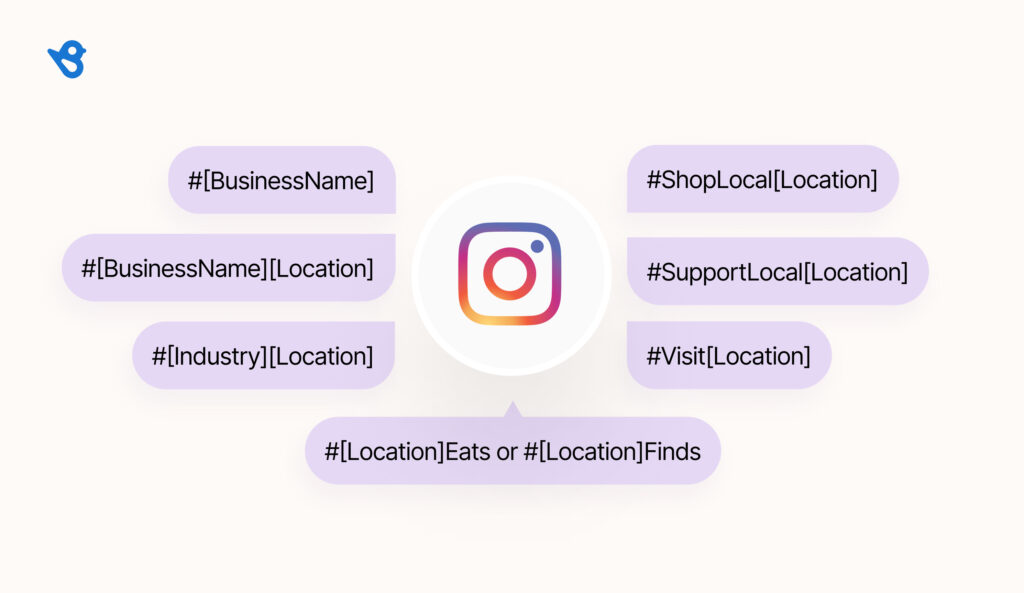
- #[BusinessName]: Customize this hashtag with your business’s name to unify content across all locations.
- #[BusinessName][Location]: For instance, #CoffeeShopNewYork, to highlight specific branches.
- #ShopLocal[Location]: Encourage local shopping, e.g., #ShopLocalMiami.
- #SupportLocal[Location]: Similar to the above, fostering community support.
- #[Location]Eats or #[Location]Finds: For food businesses or retail, e.g., #ChicagoEats or #SeattleFinds.
- #[Industry][Location]: Like #FashionMiami, targeting industry-specific and location-based audiences.
- #Visit[Location]: Encouraging visits to your location, e.g., #VisitDenver.

- #[BusinessName]: As with Instagram, use your business name as a hashtag to connect content.
- #[Location]Deals: Promote location-specific offers, e.g., #OrlandoDeals.
- #Discover[Location]: Highlight what’s unique about your location, like #DiscoverPortland.
- #[Location]Events: For promoting events in specific areas, e.g., #AustinEvents.
- #[Industry]In[Location]: Industry and location combined, such as #TechInBoston.
- #Shop[Location]: Promote shopping in your area, like #ShopAtlanta.
- #My[Location]: To evoke a sense of belonging and local pride, e.g., #MySanFrancisco.
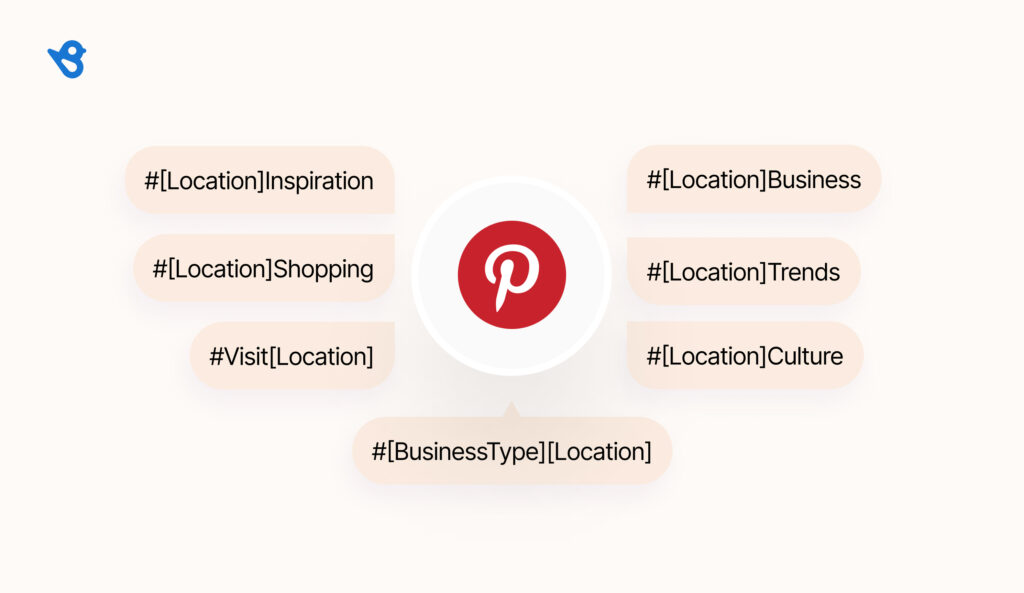
- #[Location]Inspiration: Showcase location-specific products or services, like #MiamiInspiration.
- #[BusinessType][Location]: E.g., #CafeLondon, to attract users interested in specific business types in certain areas.
- #Visit[Location]: Similar to Instagram, to inspire visits.
- #[Location]Business: To connect with other local businesses or customers, e.g., #SeattleBusiness.
- #[Location]Trends: Highlight the latest trends in your area, like #NYCTrends.
- #[Location]Culture: Showcase the cultural aspects of your location, e.g., #ChicagoCulture.
- #[Location]Shopping: Focus on shopping opportunities in your area, such as #LALShopping.
TikTok
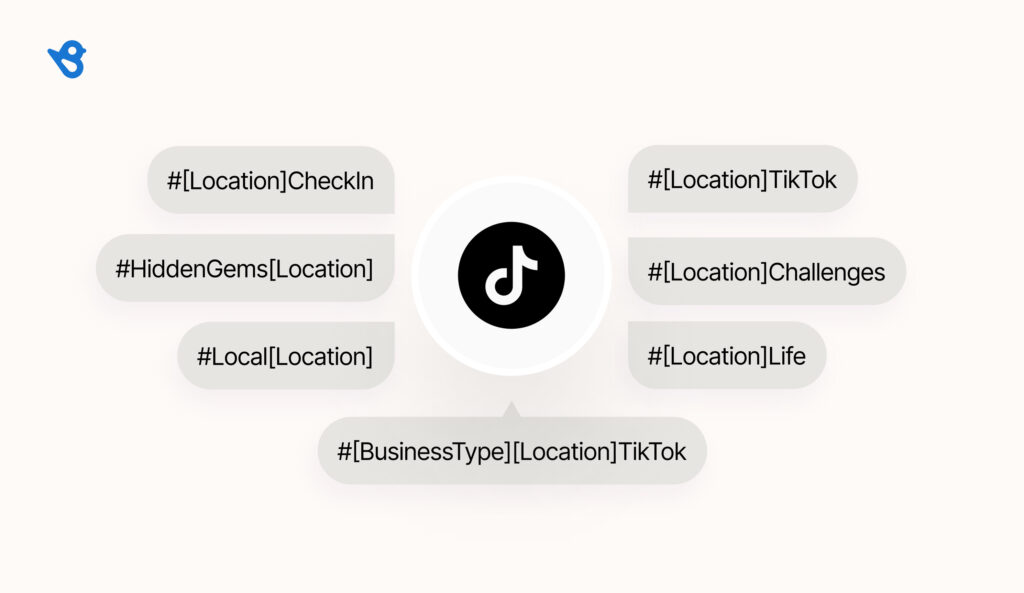
- #[Location]CheckIn: Encourage customers to check in at your location, like #DallasCheckIn.
- #[Location]TikTok: Engage with the local TikTok community, e.g., #BostonTikTok.
- #[BusinessType][Location]TikTok: Combine business type and location, such as #RestaurantNYCTikTok.
- #Local[Location]: Promote local engagement, like #LocalDenver.
- #[Location]Life: Share insights into the lifestyle of your location, e.g., #AustinLife.
- #[Location]Challenges: Create or participate in local challenges, like #SanDiegoChallenges.
- #HiddenGems[Location]: Reveal lesser-known spots or features of your location, e.g., #HiddenGemsSeattle.
X (formerly Twitter)
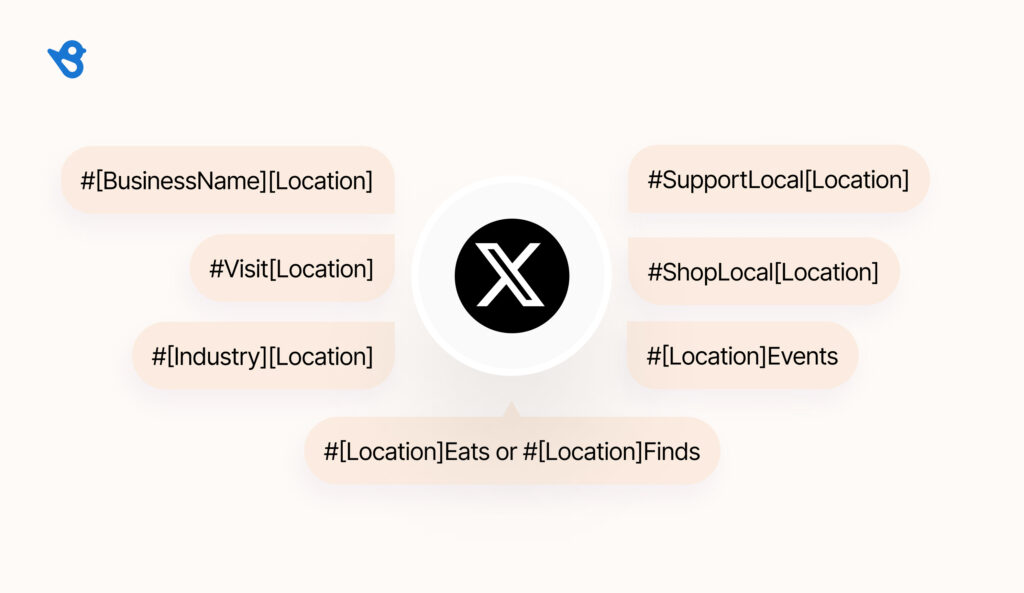
- #[BusinessName][Location]: For instance, #CoffeeShopNewYork, to highlight specific branches.
- #ShopLocal[Location]: Encourage local shopping, e.g., #ShopLocalMiami.
- #SupportLocal[Location]: Similar to the above, fostering community support.
- #[Location]Eats or #[Location]Finds: For food businesses or retail, e.g., #ChicagoEats or #SeattleFinds.
- #[Industry][Location]: Like #FashionMiami, targeting industry-specific and location-based audiences.
- #Visit[Location]: Encouraging visits to your location, e.g., #VisitDenver.
- #[Location]Events: Promote local events, e.g., #AustinEvents, to engage with the community.
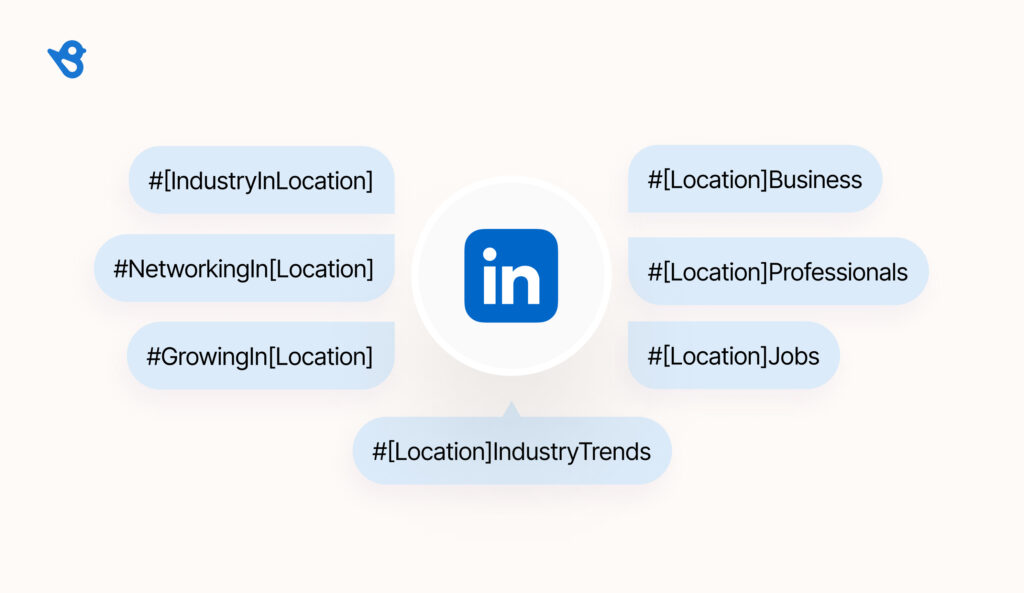
- #[IndustryInLocation]: For instance, #TechInSeattle, targets professionals in specific industries within a location.
- #[Location]Business: To connect with other local businesses or customers, e.g., #SeattleBusiness.
- #NetworkingIn[Location]: Encourage professional networking within a specific area, like #NetworkingInBoston.
- #[Location]Professionals: Target specific professional communities, e.g., #ChicagoProfessionals.
- #[Location]IndustryTrends: Share insights specific to your industry within a location, e.g., #SanFranciscoTechTrends.
- #GrowingIn[Location]: Showcase your business’s growth or highlight opportunities in specific areas, e.g., #GrowingInAtlanta.
- #[Location]Jobs: If you’re hiring in different locations, use this to attract potential employees, e.g., #DenverJobs.
Using these hashtags can help multi-location businesses segment their
How to find the best hashtags for your business?
Finding the best hashtags involves research and strategy. It’s crucial to identify hashtags that are relevant to your business and audience. Here’s how to find them:
1. Use hashtag analytics tools like Birdeye Social to provide insights into hashtag popularity, relevance, and engagement.
2. Look at the hashtags your target audience, influencers, and industry leaders are using.
3. Observe your competitors’ hashtags, especially those that get high engagement. This can offer clues on what might work for your business.
4. Keep an eye on trending hashtags related to your industry or general business. Use these when relevant to increase your content’s visibility.
5. Experiment with different hashtags to see which generates the most engagement.
Following these steps, you can create a powerful hashtag for your business and identify the best hashtags to enhance your social media strategy.
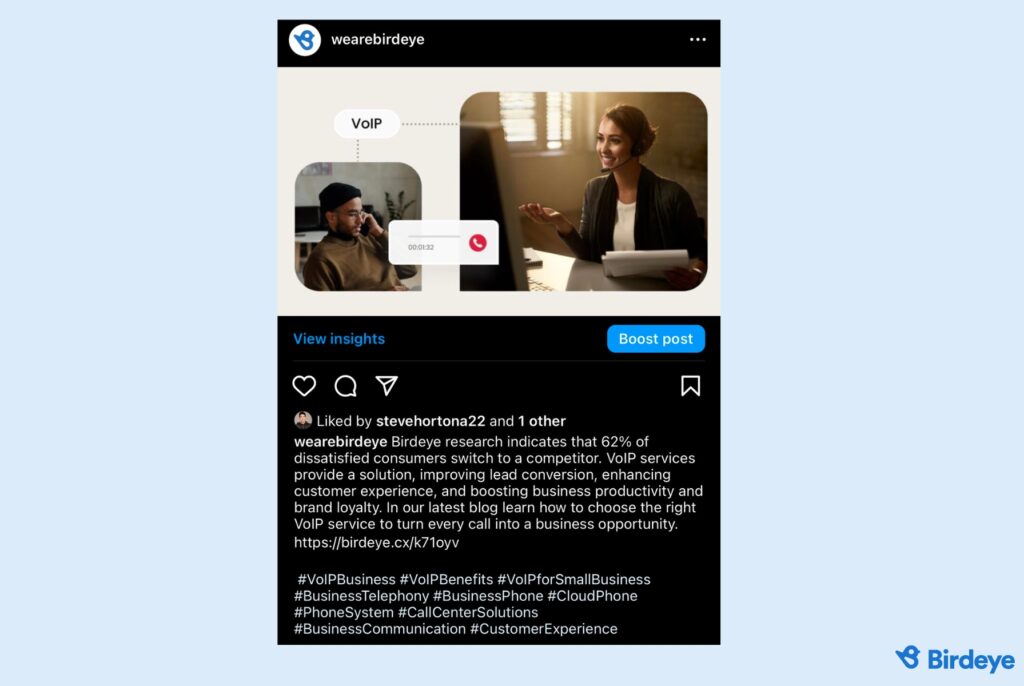
What’s the ‘3×3’ hashtag strategy?
The 3×3 hashtag strategy is a method designed to maximize the reach and engagement of your social media content by carefully selecting and categorizing hashtags. Here’s how it works:
1. Choose three popular hashtags that have a large volume of posts. These are general and widely used hashtags related to your industry or content theme.
2. Select three moderately popular hashtags. These should be more specific than the popular hashtags but still have a significant following.
3. Pick three niche hashtags. These are highly specific and may have fewer posts but target a very engaged and relevant audience.
Using a mix of popular, moderate, and niche hashtags, you can reach a broad audience while also targeting users likelier to engage with your content.
Pro-tip: Regularly analyze the performance of your hashtags. With these insights, refine your hashtag strategy and ensure it aligns with your audience's preferences and behaviors.
How to connect with your audience through hashtags?
The above-suggested steps will fail if your audience doesn’t connect with your hashtag. To get the best ROI in terms of effort and time, you must use hashtags to provide value. This can help establish your brand as a thought leader in your industry and attract a like-minded audience.
Here’s how you can use hashtags in community building:
- Identify hashtags your target audience uses and engages with.
- Actively participate in discussions around those hashtags in your industry.
- Encourage your audience to create content and use a specific hashtag.

Can a hashtag go viral?
Yes, a hashtag can go viral. When a hashtag goes viral, it has gained widespread popularity and visibility across social media platforms within a short period. This usually happens when many people use the hashtag in their posts, often in response to current events, trending topics, popular campaigns, or challenges.
For a hashtag to go viral, it typically needs to be associated with highly engaging, relatable, timely, or provocative content.
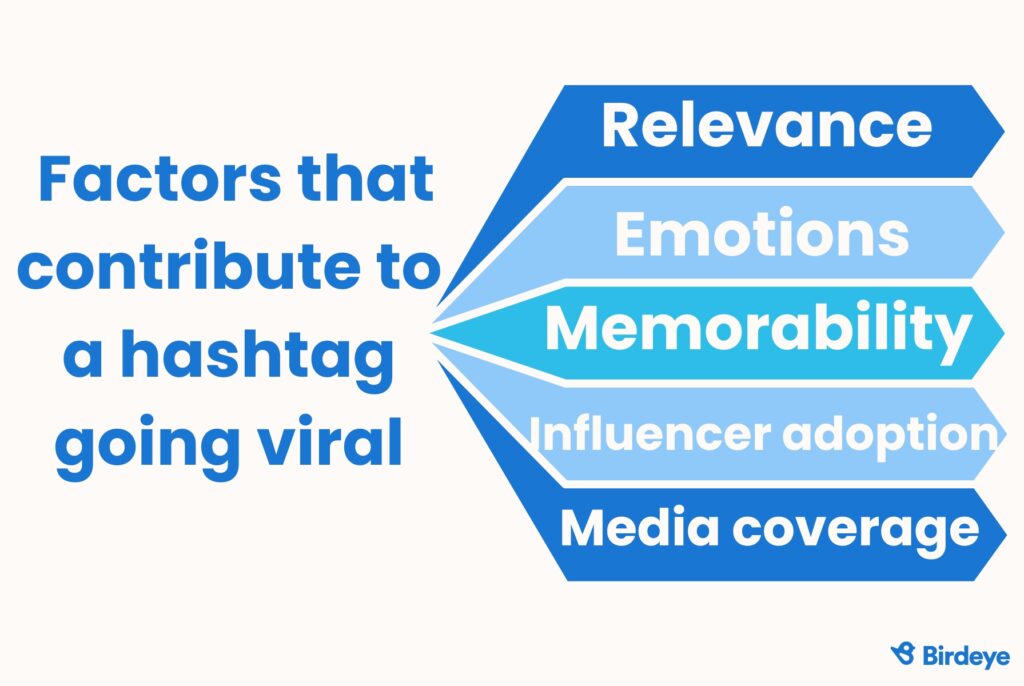
How do I find the right hashtag for my business? Research trending and relevant hashtags in your industry, use hashtag analytics tools, and observe what your competitors and audience are using. Tailor hashtags to your content and brand.
How to leverage hashtags for event marketing?
Leveraging hashtags for event marketing is a strategic way to enhance visibility, engagement, and interaction before, during, and after an event.
Here’s how to effectively use hashtags for event marketing:

Let’s check what checkmarks you must adhere to:
1. Promote your hashtag early and often
✅ Introduce the hashtag in all event-related business communications, including invitations, promotional materials, and emails.
2. Incorporate the hashtag onsite
✅ Display the hashtag prominently at the event venue — on banners, signage, name badges, and presentation slides.
✅ Encourage speakers and attendees to use the hashtag when posting about the event on social media posts.
3. Engage with participants
✅ Monitor the hashtag before, during, and after the event to engage with participants.
✅ Address any questions or feedback shared via the hashtag to provide support and enhance the attendee experience.
4. Create content around the hashtag
✅Generate content that includes the hashtag, such as live updates, behind-the-scenes looks, and key takeaways from the event.
✅ Encourage user-generated content by asking attendees to share their experiences or key learnings using the hashtag.
5. Track and analyze hashtag performance
✅ Use social media monitoring tools to track posts’ reach, engagement, and sentiment using your event hashtag.
✅ Analyze the data to understand what worked and didn’t and gather insights for future event marketing strategies.
6. Leverage the hashtag post-event
✅ Continue using the hashtag in post-event communications to share event highlights, thank participants, and provide access to resources like session recordings or presentation slides.
✅ Create a sense of community by encouraging participants to continue the conversation and networking after the event.
By strategically leveraging hashtags, you can significantly amplify your event’s reach.

Integrating hashtags with other business marketing strategies
Integrating hashtags into your business marketing strategies enhances brand visibility and engages your target audience more thoughtfully. Businesses can create a unified and impactful marketing strategy by combining hashtags with influencer marketing, SEO, and content marketing.
Here’s how they impact all these verticals:
Hashtags in influencer marketing
In influencer marketing, hashtags serve as a bridge between brands, influencers, and audiences. Influencers can use brand-specific or campaign-specific hashtags to enhance the visibility of their posts.
This extends the reach of influencer campaigns and allows businesses to track the performance and impact of their influencer partnerships through hashtag analytics.
Hashtags and SEO
Gone are times when people wondered which one to prioritize: social media or SEO. Today, Social media SEO is the reality. Content with high engagement on social media can drive more traffic to your website, improving its search engine ranking.
Social media profiles and posts often appear in search results, and using hashtags can make this content more discoverable. By integrating hashtags that align with your SEO keywords, you can create a synergy that boosts your online visibility.
Hashtags and content marketing
With generative search experience gaining a foothold, your content marketing drives more results by making your posts discoverable across platforms. By tagging your blogs, videos, infographics, and other content pieces with relevant hashtags, you can reach a wider audience interested in those topics.
FAQs on hashtags for business
Yes, hashtags can significantly enhance visibility, engagement, and audience reach for businesses, helping them to connect with current customers and attract potential ones.
While not directly, hashtags can boost engagement and brand visibility, leading to increased traffic and potential sales opportunities by reaching a broader audience.
Absolutely, people use hashtags to categorize content, participate in conversations, discover new posts, and connect with others who share similar interests.
On most social media platforms, enter the hashtag in the search bar. You’ll see a list of posts using that hashtag. You can also click on a hashtag in a post to see related content.
Businesses use hashtags to increase content visibility, engage with their audience, participate in trending topics, and categorize their posts for better discoverability.
Monitor hashtag performance using analytics tools to track engagement, reach, and conversion. Analyze data to refine your strategy and use successful hashtags more effectively.
Do Research, be relevant, and track performance.
Don’t: Overuse, be irrelevant, or hijack unrelated trending hashtags.
Make the best out of hashtags for your business with Birdeye Social
When used strategically, hashtags are a powerful tool for businesses to amplify the content’s reach, foster community engagement, and contribute to business growth.
Birdeye Social stands out as an invaluable asset for businesses aiming to harness the full potential of hashtags. By providing:
- Robust monitoring platform
- Targeted analytics
- Engagement tools
- Actionable insights
Birdeye Social empowers businesses to refine their strategies to achieve better results.
See how our customer’s business has upgraded since they integrated our platform:
Our customers, their stories: “We totally depend on Birdeye's social media calendar. We schedule out our content in advance, which is super helpful. Although we like to say we pride ourselves on each practice operating independently for things like holiday hours, we do create bulk messages and posts that can be used across multiple locations. This saves us a ton of time. It creates consistency and it's super convenient to log into one dashboard and see everything that's scheduled across different platforms.” Meghan Bingham, Senior Operations Manager, Valley Vet Care
Are you ready to boost your band with business hashtags? Let Birdeye work for you!

Originally published

